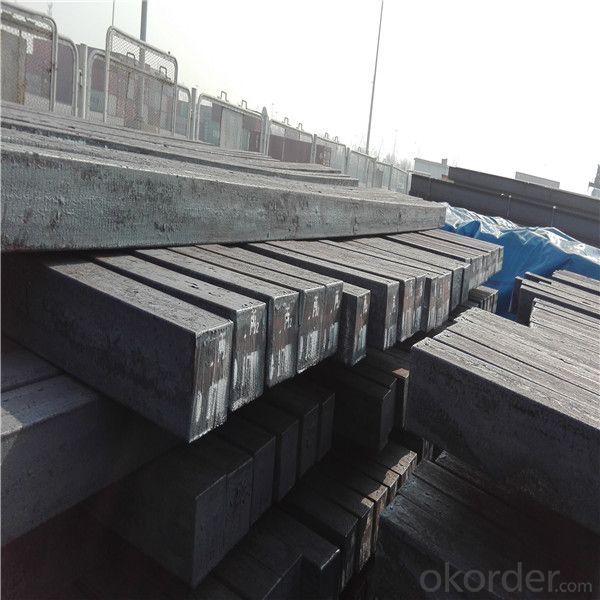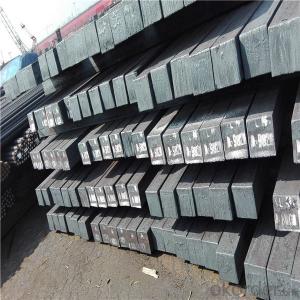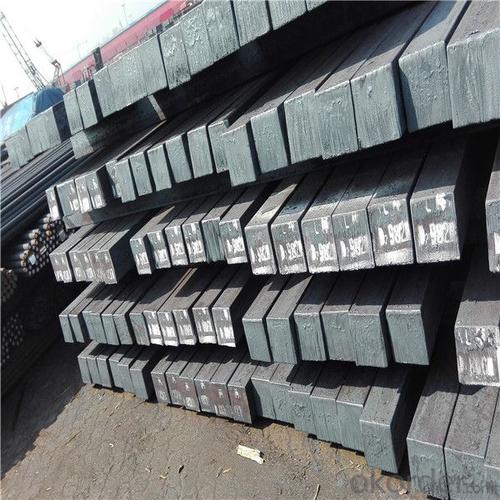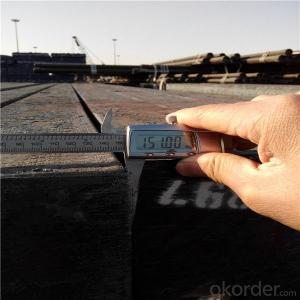Steel billet for building 165 mm x 165mm
- Loading Port:
- Guangzhou
- Payment Terms:
- TT OR LC
- Min Order Qty:
- 1000 m.t.
- Supply Capability:
- 29264 m.t./month
OKorder Service Pledge
OKorder Financial Service
You Might Also Like
Specification
Steel billet
Steel billets have distinct characteristics as compared with already furnished steel bars and products.
Billets have a specific grain structure, which enables the metal to be processed more intricately. Steel
billets are also known for their malleability and ductility, especially when exposed to varying temperatures
during shaping and molding.
The billet is mainly divided into two kinds from the shape:
Slab: cross section width and height of the ratio of the larger, mainly used for rolling plate.
Tolerance: Strictly according to the G/B and JIS standard
Delivery time: within 45 days after receiving the L/C or advanced T/T payment.
Price term: FOB/CIF/ CFR according to clients requirements
Payment terms: 100%Irrevercable L/C at sight or T/T
Gade:
Standard | C(%) | Mn(%) | S(%) | P(%) | Si(%) |
Q195 | ≤0.12 | ≤0.50 | ≤0.040 | ≤0.035 | ≤0.30 |
Q235 | ≤0.20 | ≤1.40 | ≤0.045 | ≤0.045 | ≤0.35 |
Q275 | ≤0.22 | ≤1.50 | ≤0.045 | ≤0.045 | ≤0.35 |
20MnSi | 0.17-0.25 | 1.2-1.6 | ≤ 0.050 | ≤ 0.050 | 0.40-0.80 |
3SP | 0.14-0.22 | 0.40-0.85 | ≤ 0.050 | ≤ 0.040 | 0.05-0.15 |
5SP | 0.28-0.37 | 0.50-1.00 | ≤ 0.050 | ≤ 0.040 | 0.15-0.30 |



Our service :
We have a plant and professional team to provide our best service, from the start of production until the
loading into the vessel, we have a complete quality follow up procedure, to assure our products arrives to the customer with satisfaction. Welcome new and old customers
to contact us for future business relationships! We will give you a surpise price.
Packing :
Within 30 days
1.Standard export package
2.In bundles with steel strips
3.As the requirements of the customers
FAQ:
Q: What is payment terms?
A: FOB 30% T/T IN ADVANCE AS DEPOSIT AND 70% T/T BEFORE SHIPMENT
CIF and CFR 30% T/T IN ADVANCE AS DEPOSIT AND 70% T/T AS THE COPY OF B/L OR L/C AT SIGHT
Q:How to guarantee the quality of the products?
A:We have established the international advanced quality management system,every link from raw material
to final product we have strict quality test;We resolutely put an end to unqualified products flowing into the market.
At the same time, we will provide necessary follow-up service assurance.
Q:How long can we receive the product after purchase?
A :In the purchase of product within three working days, We will arrange the factory delivery as soon as possible.
The pecific time of receiving is related to the state and position of customers.
- Q: What are the different surface treatments for improved surface lubrication in steel billets?
- To enhance surface lubrication, there are multiple techniques available for treating steel billets. These treatments target the reduction of friction and wear during manufacturing processes like rolling or extrusion. Some commonly used methods to improve surface lubrication in steel billets are: 1. Phosphating: By applying a phosphate coating to the steel surface, this treatment creates a thin layer of phosphate compound. Acting as a lubricant, it minimizes friction between the billet and machinery during processing. 2. Nitriding: Through the introduction of nitrogen into the steel surface, nitriding forms a nitride layer. This layer enhances the billet's surface hardness, wear resistance, and lubrication properties, reducing friction. 3. Electroplating: This treatment involves depositing a layer of metal, such as zinc or nickel, onto the surface of the steel billet. Besides improving lubrication, it also offers corrosion protection, extending the billet's lifespan. 4. Surface coating: Different types of coatings, such as Teflon or polymer-based coatings, can be applied to steel billets. These coatings create a low-friction surface, preventing sticking or galling during processing. 5. Shot peening: Shot peening is a mechanical surface treatment that bombards the steel surface with small, high-velocity metal shots. This process induces compressive stress in the surface layer, enhancing wear resistance and reducing friction. 6. Case hardening: Case hardening involves the diffusion of carbon or other alloying elements into the steel surface through heat treatment. This treatment forms a hardened outer layer, improving lubrication properties and reducing friction during processing. In summary, these surface treatments offer advantages such as reduced wear, improved efficiency, and extended tool life for steel billets. The choice of treatment depends on specific application requirements and the desired properties of the billet.
- Q: How do steel billets contribute to the manufacturing of consumer goods?
- Steel billets are a crucial raw material in the manufacturing of consumer goods as they serve as the base material for various steel products. These billets are used in processes such as forging, rolling, and extrusion to produce a wide range of consumer goods, including appliances, automobiles, construction materials, and machinery. The versatility, strength, and durability of steel make it an ideal choice for manufacturing consumer goods, and steel billets form the foundation for creating these high-quality and long-lasting products.
- Q: Billet heating furnace prices?
- Look at the video case, you can consult the advisory.
- Q: What are the main challenges in the quality control of steel billets?
- Several factors can affect the quality and performance of steel billets, posing significant challenges in their quality control. Here, we outline some key obstacles in this regard: 1. Chemical Composition: The accurate chemical composition of steel billets is pivotal in determining their strength, durability, and mechanical properties. However, ensuring consistent chemical composition is challenging due to variations in raw materials, melting processes, and the presence of impurities. 2. Homogeneity: It is crucial to achieve uniformity in the microstructure and composition throughout the steel billet. Inadequate mixing or non-uniform cooling can lead to inconsistencies, resulting in weak areas and uneven mechanical properties. 3. Defect Detection: Detecting and eliminating defects in steel billets is essential to prevent failures during subsequent processing and usage. Common defects include cracks, inclusions, segregation, porosity, and surface irregularities. However, accurately and promptly detecting these defects can be challenging due to their size, complexity, and location. 4. Dimensional Accuracy: Consistency in the dimensions and shape of steel billets is vital for their further processing and use in various applications. Maintaining precise dimensions requires controlling variables such as casting speed, cooling rates, and mold design. 5. Surface Quality: The condition of the surface of steel billets is critical for subsequent operations like rolling, forging, or machining. Ensuring a smooth, clean, and defect-free surface is challenging due to factors such as scale formation, oxidation, decarburization, and surface contamination during handling and storage. 6. Heat Treatment: Proper heat treatment is often necessary to achieve the desired mechanical properties in steel billets. However, controlling the heating and cooling rates, as well as the soaking times, can be challenging due to variations in equipment, temperature monitoring, and quenching techniques. 7. Traceability: Maintaining traceability and documentation throughout the production process is crucial for quality control. Tracking the origin of raw materials, process parameters, testing records, and certifications can be challenging, especially in complex supply chains. To address these challenges in the quality control of steel billets, a combination of advanced testing techniques, robust process controls, skilled personnel, and continuous improvement initiatives is necessary.
- Q: How are steel billets used in the manufacturing of pipeline systems?
- Steel billets are used in the manufacturing of pipeline systems as they serve as the raw material for producing seamless or welded pipes. These billets are heated and passed through a series of rollers to shape them into desired pipe sizes and dimensions. The resulting pipes are then further processed and coated to enhance their durability and corrosion resistance, making them suitable for transporting various fluids and gases in pipeline systems.
- Q: How are steel billets cut into desired lengths?
- Steel billets are commonly cut into desired lengths using various cutting techniques. One of the most commonly used methods is saw cutting. In this process, a high-speed circular saw equipped with a carbide or diamond-tipped blade is used to cut through the steel billet. The billet is securely clamped in place, and the saw blade is brought down onto the billet, slicing through it to create the desired length. Another method used is torch cutting, which involves the use of an oxy-fuel torch. The torch produces a high-temperature flame that is directed onto the billet, melting and cutting through the steel. Torch cutting is often used for larger and thicker steel billets, as it allows for more flexibility in cutting irregular shapes or angles. Additionally, plasma cutting is another technique employed for cutting steel billets. Plasma cutting involves the use of a plasma torch that generates an electrically conductive plasma arc. This arc melts the steel and blows away the molten metal, resulting in a precise and clean cut. Plasma cutting is particularly useful for cutting through thicker steel billets or for intricate shapes and designs. Overall, the cutting technique used to cut steel billets into desired lengths depends on factors such as the size and thickness of the billet, the desired precision and accuracy, and the specific requirements of the end product.
- Q: How do steel billets contribute to the overall fire resistance of a structure?
- The overall fire resistance of a structure is enhanced by steel billets in several ways. Firstly, steel billets are made of a non-combustible material, meaning they cannot burn or aid in the spread of fire. By incorporating steel billets into a building's construction, the risk of fire propagation is significantly reduced. Secondly, steel possesses a high melting point, typically around 1370 degrees Celsius. This characteristic enables steel to maintain its structural integrity and resist deformation even under intense heat. By using solid steel blocks, known as steel billets, the structure gains strength and stability that can withstand the impact of a fire. Moreover, steel exhibits low thermal conductivity, resulting in poor heat conduction. This property helps to slow down the transfer of heat from the fire to the surrounding areas of the structure. By acting as a barrier, steel billets hinder rapid temperature rise, allowing occupants more time to evacuate and firefighters more time to extinguish the fire. Furthermore, steel billets are frequently utilized in constructing fire-resistant walls or barriers within a structure. These walls are designed to compartmentalize the building, confining the spread of fire and smoke to specific areas. By incorporating steel billets into these fire-resistant walls, the overall construction becomes more durable and capable of enduring the extreme conditions of a fire. In conclusion, steel billets play a crucial role in enhancing the overall fire resistance of a structure due to their non-combustible nature, high melting point, low thermal conductivity, and ability to reinforce fire-resistant walls. By incorporating steel billets into the construction process, buildings can achieve greater resilience against fire incidents, ensuring the safety of occupants and minimizing fire damage.
- Q: What are the different types of steel billet shearing techniques?
- There are several different types of steel billet shearing techniques used in the industry. These techniques vary based on the specific requirements of the cutting process and the desired end product. Some of the commonly used steel billet shearing techniques include: 1. Guillotine Shearing: This technique involves using a guillotine-style shear blade to cut through the steel billet. The blade is lowered onto the billet, applying a shearing force that slices through the material. 2. Circular Shearing: In this technique, a circular shear blade is used to cut through the billet. The blade rotates at a high speed, applying a cutting force as it comes into contact with the billet. 3. Band Saw Shearing: A band saw is used to cut through the steel billet in this technique. The saw blade, made of a continuous band of teeth, moves in a continuous loop, slicing through the billet as it passes through. 4. Rotary Shearing: This technique involves using a rotary shear to cut through the billet. The shear consists of a set of rotating blades that grip the billet and cut through it as it moves through the machine. 5. Flame Cutting: Also known as oxyfuel cutting, this technique uses a high-temperature flame to melt and cut through the steel billet. A stream of oxygen is directed onto the billet, creating a chemical reaction that allows for the cutting process. 6. Plasma Cutting: Plasma cutting uses a high-velocity jet of ionized gas to melt and cut through the steel billet. The gas is heated to an extremely high temperature and directed onto the billet, resulting in a clean and precise cut. Each of these steel billet shearing techniques has its own advantages and limitations, depending on factors such as the size and thickness of the billet, the required accuracy of the cut, and the desired speed of the cutting process.
- Q: What are the market trends and growth prospects for steel billets?
- Steel billets are a crucial component of the steel industry, serving as the raw material for various downstream applications. The market trends and growth prospects for steel billets are largely influenced by factors such as global economic growth, infrastructure development, and the demand for steel in various sectors. One of the significant market trends for steel billets is the increasing demand from the construction industry. With rapid urbanization and infrastructure development in emerging economies, the need for steel-intensive construction projects is rising. Steel billets are widely used in the construction of bridges, buildings, and other infrastructure projects, driving the demand for this product. Another market trend is the growing demand for steel billets in the automotive industry. The automotive sector is a major consumer of steel, and as the industry shifts towards lightweight and high-strength materials, the demand for steel billets is expected to grow. Steel billets are used in the production of various automotive components, including engine parts, chassis, and suspension systems. Furthermore, the increasing focus on renewable energy sources, such as wind and solar power, is expected to drive the demand for steel billets. Wind turbines and solar panel structures require steel components, and as renewable energy projects continue to expand globally, the demand for steel billets is likely to witness significant growth. In terms of growth prospects, the steel billets market is expected to experience steady growth in the coming years. The Asia-Pacific region, particularly China and India, is expected to dominate the market due to their robust construction and infrastructure sectors. These countries have massive urbanization projects and ongoing infrastructure development plans, which will drive the demand for steel billets. Additionally, the recovery of the global economy after the COVID-19 pandemic is expected to boost the demand for steel billets. As economies rebound and industrial activities pick up pace, the demand for steel in various sectors, including construction, automotive, and energy, will increase, positively impacting the market for steel billets. However, it is important to note that market trends and growth prospects for steel billets can be influenced by factors such as fluctuations in raw material prices, trade policies, and environmental regulations. Moreover, the increasing adoption of alternative materials, such as aluminum and composites, in certain applications may pose a challenge to the growth of the steel billets market. In conclusion, the market trends for steel billets are driven by the demand from the construction, automotive, and renewable energy sectors. The growth prospects for this market are promising, particularly in the Asia-Pacific region, as economies recover from the pandemic and infrastructure projects gain momentum. However, challenges such as raw material price fluctuations and competition from alternative materials should also be considered.
- Q: How do steel billets contribute to the transportation industry?
- Steel billets are a vital component in the transportation industry as they are used to manufacture various parts and components for vehicles. These billets are transformed into products like engine blocks, chassis frames, axles, and suspension systems, which provide strength, durability, and stability to vehicles. Additionally, steel billets are also used to produce railway tracks and infrastructure, ensuring safe and efficient transportation of goods and people. Overall, steel billets play a crucial role in enhancing the performance, safety, and reliability of transportation systems.
Send your message to us
Steel billet for building 165 mm x 165mm
- Loading Port:
- Guangzhou
- Payment Terms:
- TT OR LC
- Min Order Qty:
- 1000 m.t.
- Supply Capability:
- 29264 m.t./month
OKorder Service Pledge
OKorder Financial Service
Similar products
Hot products
Hot Searches
Related keywords






















